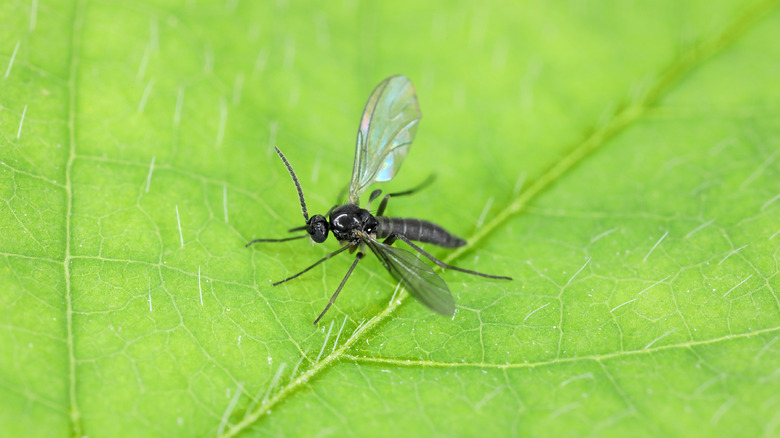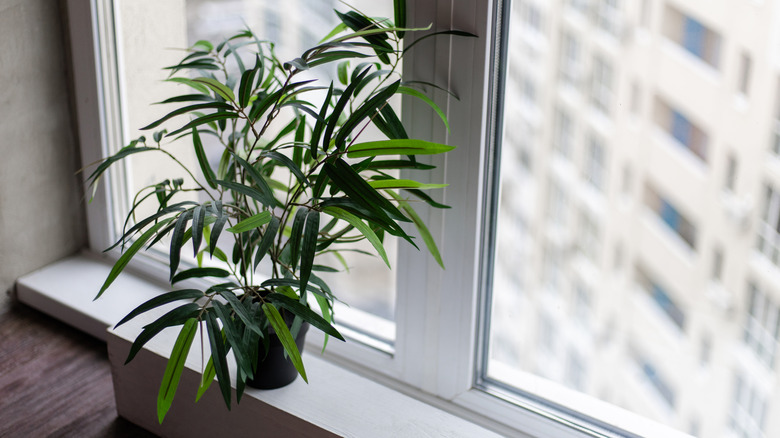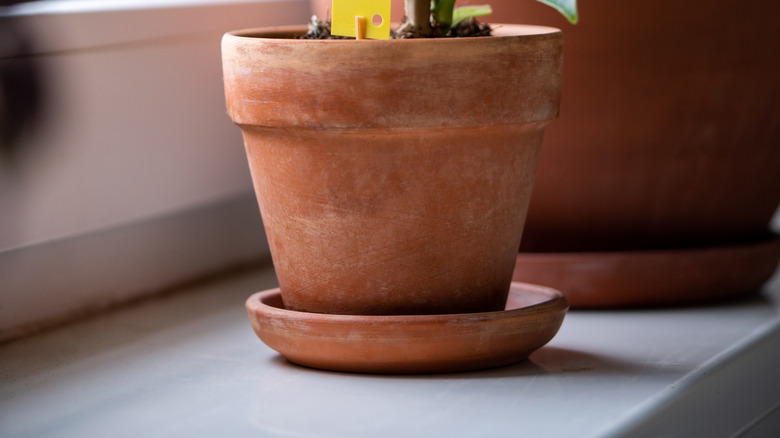Avoid A Gnat Infestation By Avoiding This Detrimental New Plant Mistake
What's the first thing you should do when you bring home a new plant? If you answered, "find it the perfect spot with the rest of your plants," think again. It's best not to place a new addition close to your existing collection, because the newcomer may be infested with gnats. Dealing with one plant with gnats is simple; treating a house-wide infestation is way more frustrating.
Not every new plant has gnats, but it's a common enough problem that it's worth minimizing the risk. The gnats that live on plants are different from those that hang out by your sink or trash can. These tiny black bugs aren't fruit flies, but fungus gnats: they eat fungi, decaying plant matter, and plant roots. They're shaped like mosquitoes but are smaller. And while the adult flies don't hurt people or plants, they're a real nuisance and their larvae can harm plant health.
Fungus gnats thrive in moist plant soil, so houseplants are prime real estate for these pests. Geraniums, poinsettias, carnations, and African violets are most vulnerable, but any houseplant is susceptible. These insects tend to run rampant in nurseries and greenhouses, and any potting mix with organic matter that's still decomposing is also likely to have them. Since fungus gnats reproduce so quickly, the problem can spread to your other plants in no time. It's best to quarantine every new plant regardless of where you got it, just in case.
How to quarantine a new plant
When you bring home a new plant, put it in a spot away from your existing collection — a separate room is best. If you lack the space, use a loose plastic bag or a clear plastic bin to keep the plant isolated without blocking its access to light. Move covered plants outside of direct sunlight to prevent heat damage.
Adult gnats are easy to spot flying around, but their eggs can remain dormant in the growing medium, so they may not be immediately visible when you purchase the plant. If the conditions are right, the eggs will hatch into larvae within a few days, and the larvae will grow into adults in about two weeks. Some people recommend quarantining for only a couple days or a single week, but that's not quite enough time to be sure no fungus gnats are hitching a ride. Your new plant should remain in quarantine for several weeks if you want to keep fungus gnats out of your home.
While the plant is isolated, inspect it often, turning over the soil to check for gnats or larvae. You can also tuck a piece of raw potato into the soil; the larvae will be attracted to it and become visible. Other signs that larvae are feeding on a plant's roots include wilting, yellowing, or a general lack of growth. This isolation period is also a good time to check for other common pests like mites, mealybugs, or thrips.
What to do if your new plant has fungus gnats
While it can be disappointing to find pests on a new plant, it's easier to banish pesky gnats from houseplants when you catch the problem before it spreads. The most effective treatment against fungus gnats is twofold. The first step is to cut down on water, allowing the top of the soil to fully dry out between waterings. Similarly, make sure that soil drainage is highly efficient. Adding perlite or sand to the potting mix can help with this. The second step is to install sticky traps in the container to catch as many adults as possible before they lay more eggs in the soil.
While spraying a quarantined plant with an insecticide can help curb infestations by other pests, like mites, it's trickier to control fungus gnats that way because the product needs to be effective long-term. However, mosquito dunks can kill the larvae and prevent new gnats from hatching, especially if you keep using them consistently and alongside the other procedures described above. Just add a piece of mosquito dunk to the water you use for the plant. Unfortunately, if your new plant is severely infested, you may have to eventually evict it from your home. On the other hand, if it's gnat-free for a few weeks, you can rest assured that it's ready to join its new plant pals without harming them.


